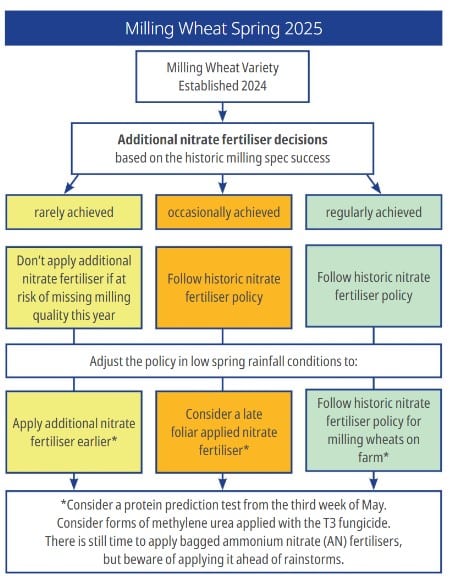Optimising nitrogen use and protein in milling wheat – South East Farmer
Hutchinsons’ Tim Kerr, Crop Nutrition Manager, and Leo Page, Farm Business Consultant, share their views on how to optimise nitrogen use to meet protein specifications without overstepping economic thresholds ...
Modern wheat varieties have huge yield potential, but growers have to be realistic about whether or not these can be achieved on their own farms.
A well-timed application of nitrogen after the flag leaf final dressing will increase the amount of nitrogen available to crops during that crucial stage of protein development.
Without a well-timed late application of nitrogen, crops may struggle to contain enough protein to satisfy the requirement for yield and quality. The later this dressing is applied, the more influence it will have on grain protein up to ear emergence. After flowering, the uptake of nitrogen declines.
The experts pose three pivotal questions to ask around late season nitrogen requirements for a group 1 milling wheat established in autumn 2024 with the aim of being sold for a milling premium with a protein threshold of HFN250.
1. WHAT IS THE LIKELIHOOD OF ACHIEVING MILLING WHEAT SPEC?
This is an important starting point and should be based on the historical success of meeting milling spec weight with a particular variety. If regularly or even occasionally achieved, then it would be sensible to follow past nitrogen fertiliser strategies. If not, don’t apply additional nitrogen; it doesn’t make economic sense.
Recommendations also shift with low spring rainfall. If the weather stays dry, later applications of foliar urea at the milky ripe stage will become more important.
Beware the terms of some milling wheat contracts which exclude the use of foliar urea. Alternatively, consider forms of methylene urea applied with the T3 fungicide which is now a well-established practice, very crop safe and reduces the need for extra field passes.
2. SHOULD I THEN CONSIDER A LATE NITROGEN APPLICATION TO PUSH FOR PROTEIN?
Use the protein prediction test to decide whether a late application of nitrogen is needed. Hutchinsons have been using this test since 2019 and Andrew Pitts at Helix National farm uses it routinely for his milling wheat samples.
The test involves digging up five to 10 wheat plants from across a field and sending them to the lab. Samples can be taken from third week in May onwards. The test retails at £36.50 per sample.
For further details see www.hillcourtresearch.co.uk/product/protein-prediction-in-milling-wheat
3. HOW CAN I CALCULATE THE EFFECT OF MORE NITROGEN ON MY BREAK-EVEN COSTS WHILE ACCOUNTING FOR UNCERTAINTY AND VOLATILITY?
Milling wheat requires about 5kg of extra nitrogen per tonne of wheat, so a 10-tonne milling crop needs about 50kgs extra nitrogen than the equivalent feed wheat crop. Taking into account the reliability of achieving milling spec and depending on the fertiliser product bought, this is an additional variable input cost of £5-£6.50/tonne of wheat, which, when the crop is sold for an additional milling premium, is money well spent.

